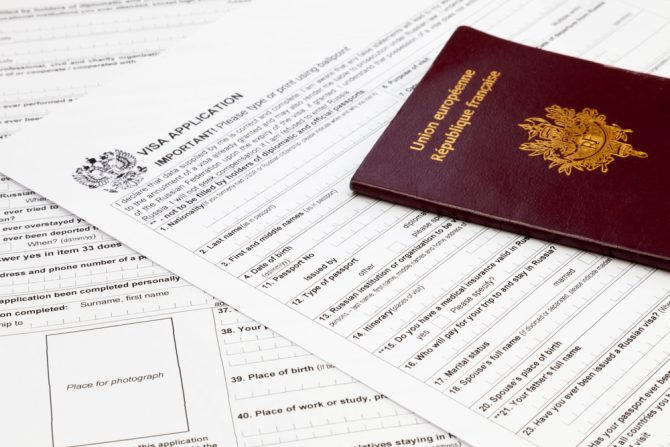Applying For Your French Long-Stay Visa: Step by Step
Essential Reading


Our easy-to-follow guide takes you through the process of applying for your French long-stay visa (visa de long séjour). Find out what documentation you need to provide, how to apply online, how much it costs, and what to expect at your visa application interview.
What is a Long-Stay Visa in France?
If you plan to visit France for more than 90 days in a 180-day period or want to live, work, or study in France, you’ll need to apply for a long-stay visa. The Long-Stay Visa Equivalent to a Residence Permit (Visa de Long Séjour Valant Titre de Séjour or VLS-TS) allows you to stay in France for up to a year and is also the stepping stone to applying for permanent French residency and your Carte de Séjour.
Use our guide to French visas to find out if this is the right visa for your needs. If so, let’s get started.
When should you apply for your French long-stay visa?
You can file your application for a long-stay visa VLS-TS from three months before your planned date of arrival in France. Processing times vary depending on the country you are applying in, but it’s a good idea to start as early as possible to leave enough time – you will need to make and attend an interview at your nearest French embassy or visa centre.
How easy is it to get a long-stay visa?
Many non-EU citizens receive long-stay visas to visit France each year, and if you are eligible for a long-stay visa and have all the necessary paperwork, there is every chance your application will go through without a hitch.
However, even if this is the case, remember that France (as always!) is meticulous over documentation. You will need to present every single document requested, as well as any supporting documentation if the original document doesn’t completely meet the requirements. Do not expect to be able to ‘explain away’ any missing documents, and if in any doubt about what documents will be accepted, double-check with your embassy or visa before your interview and bring all possibilities with you. In fact, this is the ‘golden rule of all French administration’ – the more paperwork you have to back up your position, the better!
Remember that these long-stay visas are, in many cases, the first step to permanent residency, so it is understandable that the entry requirements are strict. Every visa application is considered on an individual basis, so it is impossible to offer guarantees. However, if you have a strong reason for your visit to France (enrolment in a study program, a job contract and work permit, or you own a French property and have sufficient income and healthcare coverage), and you are able to supply every required document, there is a good chance that your application will be approved.
Step One – Select Your Visa Type
Find out what kind of long-stay visa you need – our article on categories and eligibility for French long-stay visas will talk you through the different types. Start your application process by using the visa wizard on the France Visas website here.
Step Two – Prepare Your Documents
The visa wizard will give you a list of documents that you will need to start your application process. These may vary depending on your nationality, country of application, marital status, and type of visa, so be sure to check the list carefully. However, some of the documents you should be prepared to present include:
- Your passport (this must be less than ten years old, with a validity of at least three months longer than the visa expiry date you are applying for). You will need to scan all relevant pages (including stamped pages and previous visas).
- Proof of residence in the country you are applying from if you are not a citizen
- 2 x ID photographs (following passport-style regulations)
- Proof of your socio-economic situation (retired, employed, self-employed, etc.)
- An attestation stating the purpose for your stay (for example, that you are a second-home owner wishing to visit or carry out maintenance on your holiday home) and that you will not exercise any professional activity in France (for visitor visas only)
- Proof of your private health insurance to cover your first year in France.
- Proof of your French residence, rental agreement, or intended place of residence. This can be a hotel, proof of homeownership, or an attestation from your host.
- Proof of sufficient funds (for example, three months of UK bank statements showing your salary with your full name and address, those of your spouse/partner along with your marriage certificate, or a savings account with the full amount).
Note: if you are unsure about some of the above requirements, our French Visas and Residency FAQ might have some of the answers.
Step Three – File Your Application Online
Once you have collected all the relevant documents, click ‘submit online application’ at the bottom of the visa wizard page. You will be asked to create an account, which means you can save your application and revisit it or add any missing documents before submitting it.
Once you have filled in the online visa application form and attached all the relevant documents (typically in a pdf or jpg form, but always follow the specific instructions given), you can submit your visa application.
The visa application fee will be payable at the time of submitting your application. This is a processing fee paid to the visa centre handling your application and is non-refundable, even in the case that your application is refused. Fees vary depending on the country of application, but for example, in the UK, it is £26 payable to TLSContact, while in the US, it’s $38.20 through VLS Global. Additional credit card transaction fees may also apply.
Step Four – Book Your Visa Appointment
Once you’ve paid your fee and lodged your application, you will be able to book your appointment at your nearest French embassy or visa centre. This in-person appointment is essential to securing your visa and should be organised as soon as possible – or a minimum of two weeks before your departure date.
*IMPORTANT* You must print out your receipt and CERFA application form (and it must NOT have the word DRAFT on it) and bring it to your appointment with you. The easiest time to do this is right after you submit your application, so remember to print or save the documents before you close the window.
Step Five – Prepare For Your Visa Interview
Along with your printed receipt and CERFA form, be sure to bring all the required documents on the list provided – make sure you bring both the originals and copies. It’s a good idea to bring any supporting documentation, too, just in case.
Step Six – Attend Your Visa Interview
Attend the appointment at your nearest French embassy or visa centre, where you will be asked to present all the required documents. The meeting takes around 20 minutes, and they will review your application and documents, capture your biometric data (photo and fingerprints) for your visa, and collect your visa application fee (€99 but additional service charges of no more than €40 may be applied if your visa is processed by an external service provider). Your passport will be retained.
Step Seven – Receive Your Long-Stay Visa for France
You should be able to track the progress of your application online, but you will be notified when your visa is ready to collect from the embassy or visa centre. It’s also often possible to organise for your passport and visa to be sent to you by courier (extra costs apply).
Step Eight – Arrival in France
On arrival in France, don’t forget to get your passport stamped – if you arrive in France via another country, you must present yourself at your local préfecture to get your passport stamped with your date of arrival. If flying to France, be prepared to present your supporting documents at the border, including proof of your accommodation, sufficient funds, and health insurance certificate.
Step Eight – Validate Your Visa
You must validate your VLS-TS visa within three months of arriving in France – failure to do so will not only mean that you are unlawfully residing in France, but it also means you won’t be able to leave and return to France for the duration of your visa. The validation process can be done online here – you will need to enter the information on your visa and additional personal information, give your date of arrival in France and your French address, and pay the state tax of €200.
NOTE: It may not be made clear at the time of applying that you need to validate your visa – if in doubt, there is a full list of visas that this applies to here.
Depending on your visa, nationality, and circumstances, you may also be contacted by the OFII (French Office for Immigration and Integration) to carry out a medical. This report will be required if you plan to apply for a resident card (carte de séjour) at the end of your long-stay visa.
Moving to France?
From applying for your visa and opening a French bank account, to integrating in your new community – FrenchEntrée is here to help! Let our Essential Reading and Visa & Residency articles guide you through the whole process, then visit our Owning Property, French Tax, Healthcare, and Life in France zones for everything else you need to know.
Disclaimer: Our Essential Reading articles are designed to give an overview of the visa requirements and procedures for moving to France. We always check our information against the official government information made available to the public, however, please remember that all visa applications are considered on an individual basis and the exact requirements, fees, or application procedure may vary. Unless you are an EU citizen, obtaining a French visa is not a right, and we cannot guarantee that your visa will be approved.
Share to: Facebook Twitter LinkedIn Email



